6 Best Third-Party Risk Management Tools
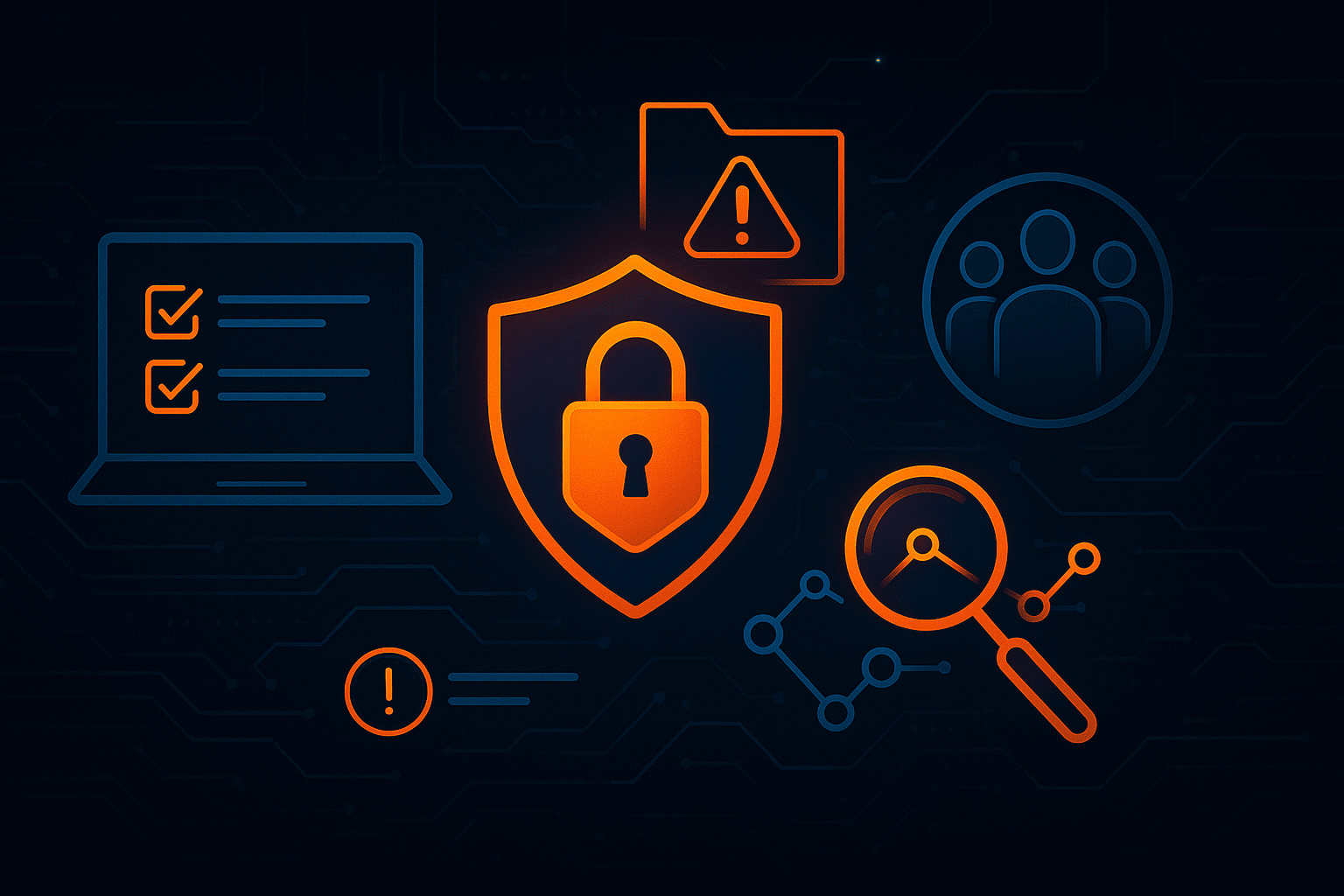

Third-party risk management has never been more critical, which is why there’s added pressure to pick the right tools to handle it.
From automated security screenings and real-time risk intelligence to deep compliance monitoring, TPRM platforms come in many different flavors.
We’ve reviewed six of the best options available today, giving you a solid starting point for choosing the right fit for your organization.
UpGuard streamlines the entire third-party risk management lifecycle, from vendor onboarding and assessments to continuous monitoring and offboarding.
Designed with financial services, technology, and healthcare in mind, it’s primarily a cybersecurity platform with robust breach prevention and vendor monitoring capabilities.

Source: UpGuard
Core features include security ratings, breach detection, dark and deep web monitoring, and automated risk questionnaires.
With pre-configured questionnaires such as NIST, ISO, and SIG, as well as recently introduced AI-powered assessments, risk teams can significantly reduce manual work.
The AI module covers most documentation checks, flags relevant changes, and supports every finding with verifiable evidence.
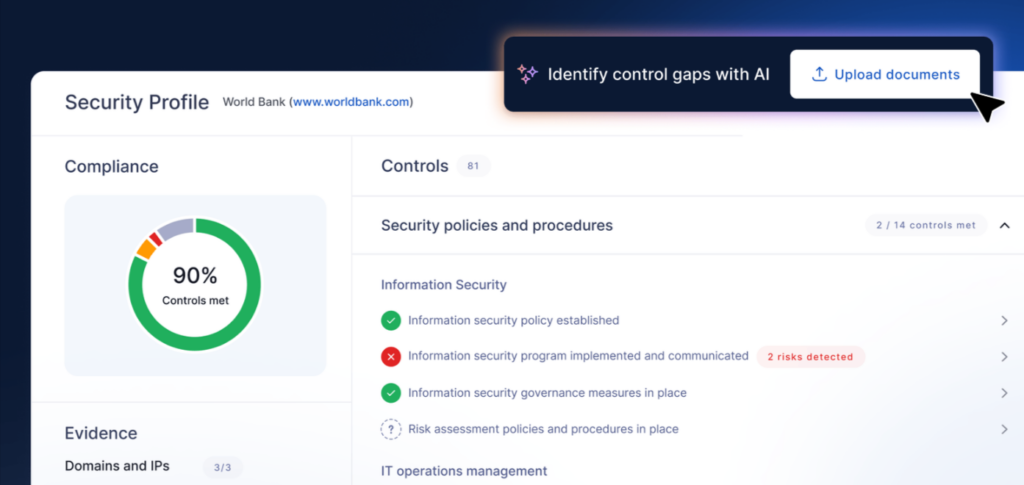
Source: UpGuard
This means compliance gaps are easier to identify, while traceable citations and tags help teams verify relevance, validity, and compliance.
AI-assisted workflows are complemented by remediation tools that enable teams to prioritize and address risks fast.
When it comes to reporting, dedicated dashboards and export-ready reports make it simple to showcase your organization’s security posture at any time.

Source: G2
Dark web monitoring and data leak detection features set UpGuard apart from more generalist platforms, which makes it an excellent match for organizations that want to focus on cybersecurity concerns.
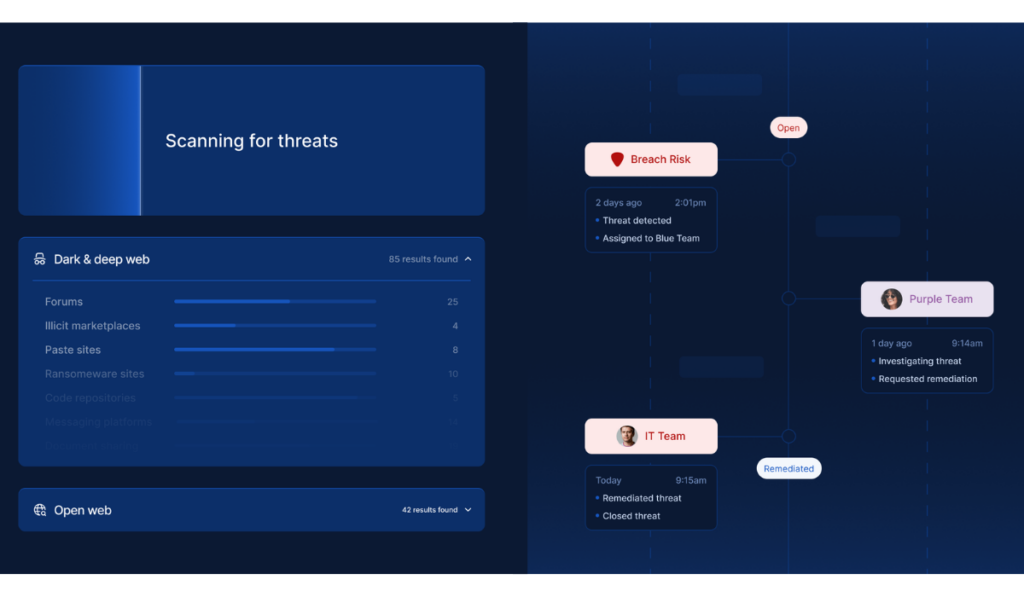
Source: UpGuard
On the other hand, this tool doesn’t offer deep business intelligence on third parties like Veridion does, for example.
However, such data can be integrated in UpGuard to enrich vendor profiles.
While users like UpGuard’s core capabilities and dashboards, they also frequently report integration issues and a lack of clarity, suggesting a learning curve.
Both enterprises and smaller businesses voiced similar concerns about limited customization options for risk questionnaires, as well as overly sensitive notifications for minor issues.

Source: G2
In terms of pricing, UpGuard offers a free plan, a 14-day free trial, and a Starter plan at $1,599/month.
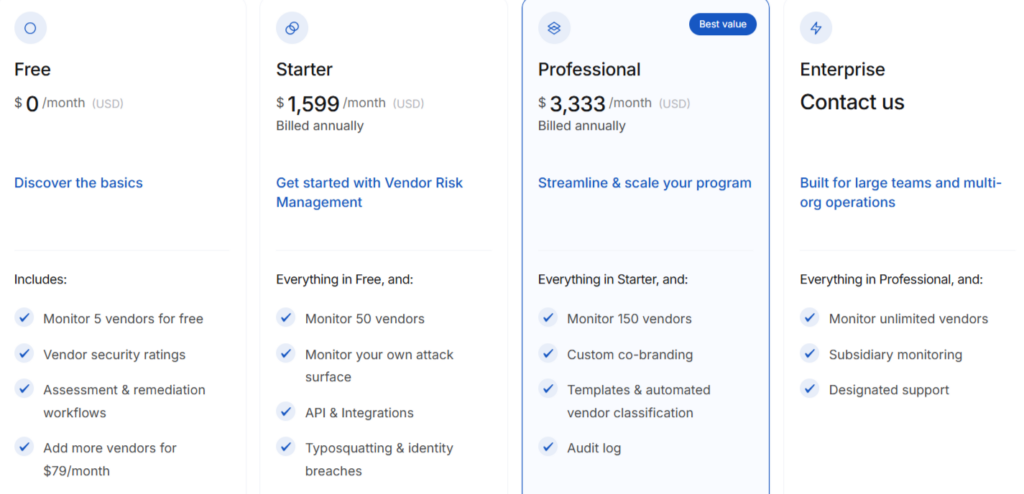
Source: UpGuard
While only Enterprise pricing is listed as custom, separate modules like dark web monitoring are likely to cost extra.
For enterprises where safeguarding sensitive data is paramount, UpGuard offers an interesting blend of AI-powered compliance checks and unmatched breach detection that make it a strong TPRM contender.
SecurityScorecard enables continuous risk monitoring, benchmarking against cybersecurity norms, and direct collaboration with vendors to remediate issues.
Well-established in cyber ratings, you can easily scale to large vendor ecosystems and continuously assess external security posture, assigning letter grades (A–F) based on breach likelihood and threat exposure.
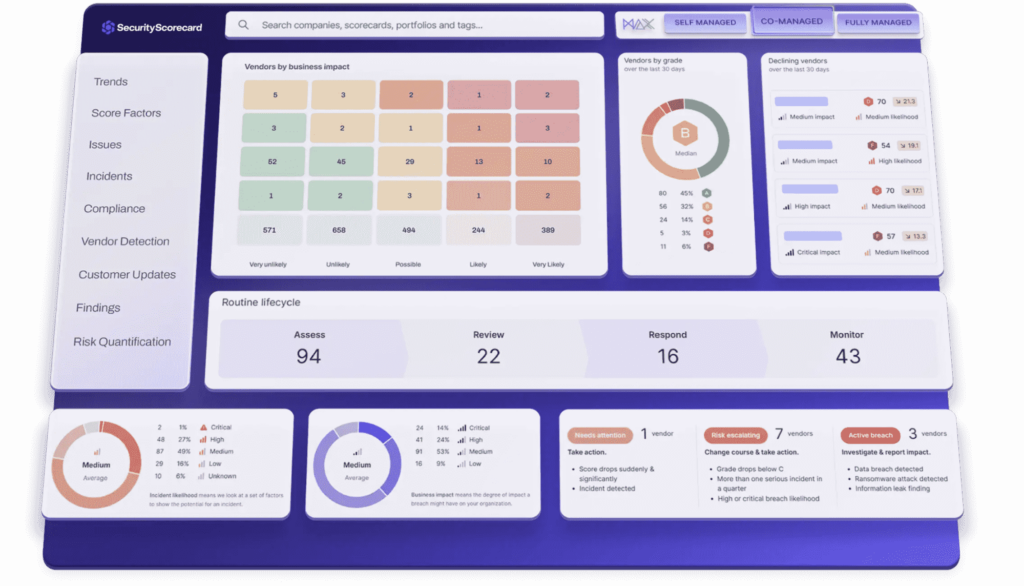
Source: SecurityScorecard
Unlike UpGuard, SecurityScorecard focuses exclusively on external cyber posture, helping you map the external attack surface across your entire supply chain and gain targeted insights.
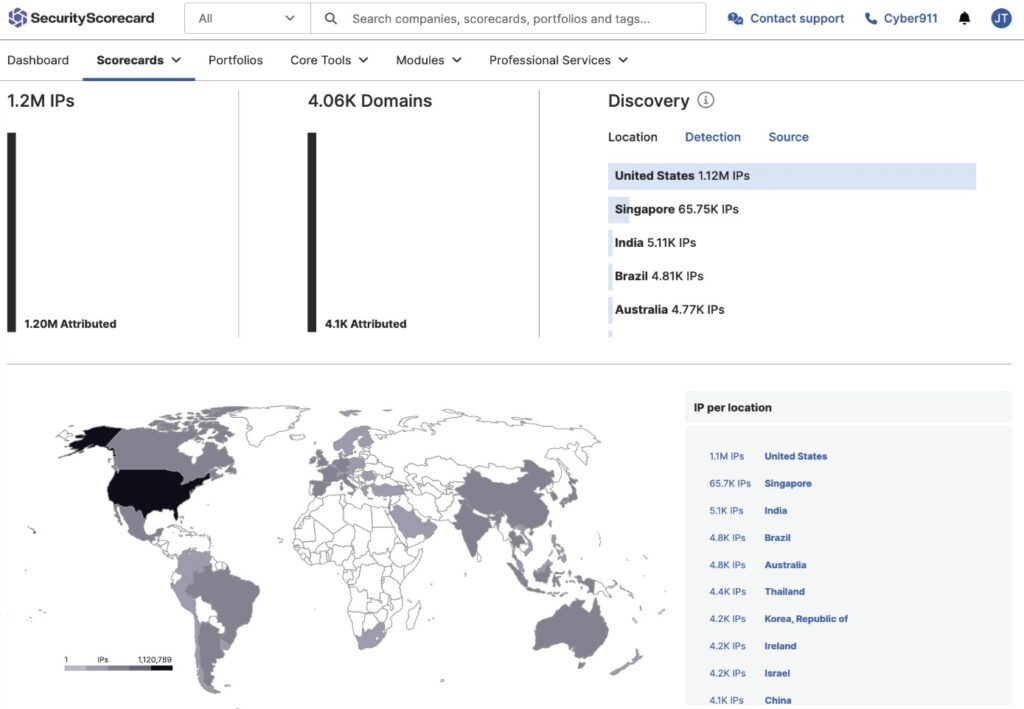
Source: SecurityScorecard
Like similar platforms, automated TPRM workflows enable you to uncover vulnerabilities, share findings instantly with vendors, and act quickly to reduce exposure.
Plus, SecurityScorecard’s Automatic Vendor Detection feature gives you additional control and insight into separate incidents and their impact across your network.
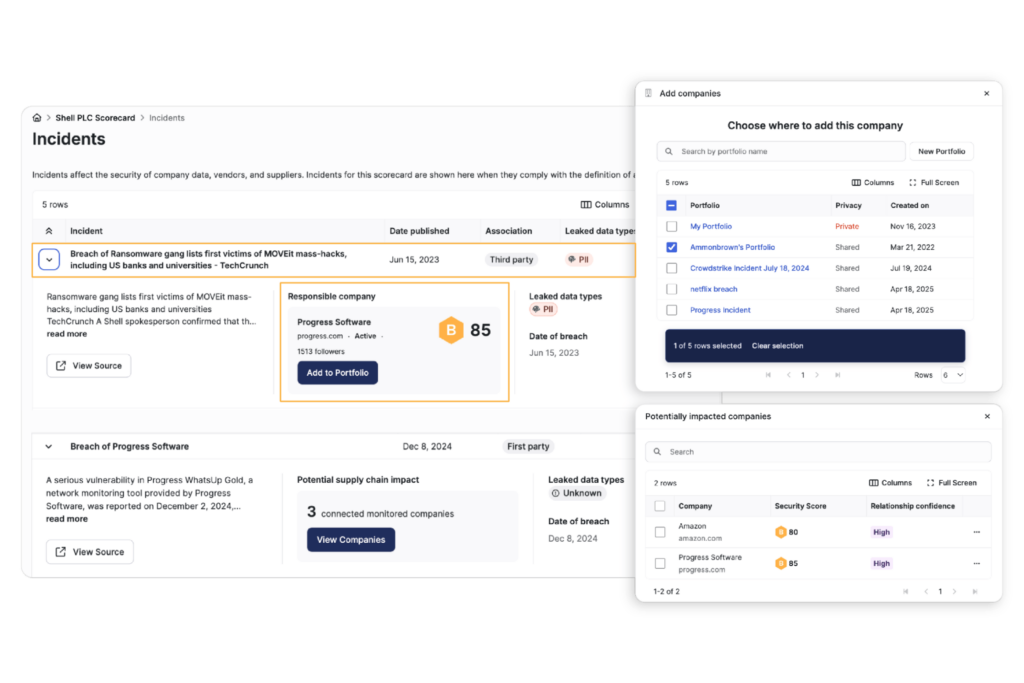
Source: SecurityScorecard
In addition to immediate detection and monitoring, SecurityScorecard’s supply-chain risk intelligence module highlights critical vendors and provides a snapshot of vulnerabilities that could threaten your operations.
Trend graphs and other visual elements make it easier to track risk over time and address emerging concerns.
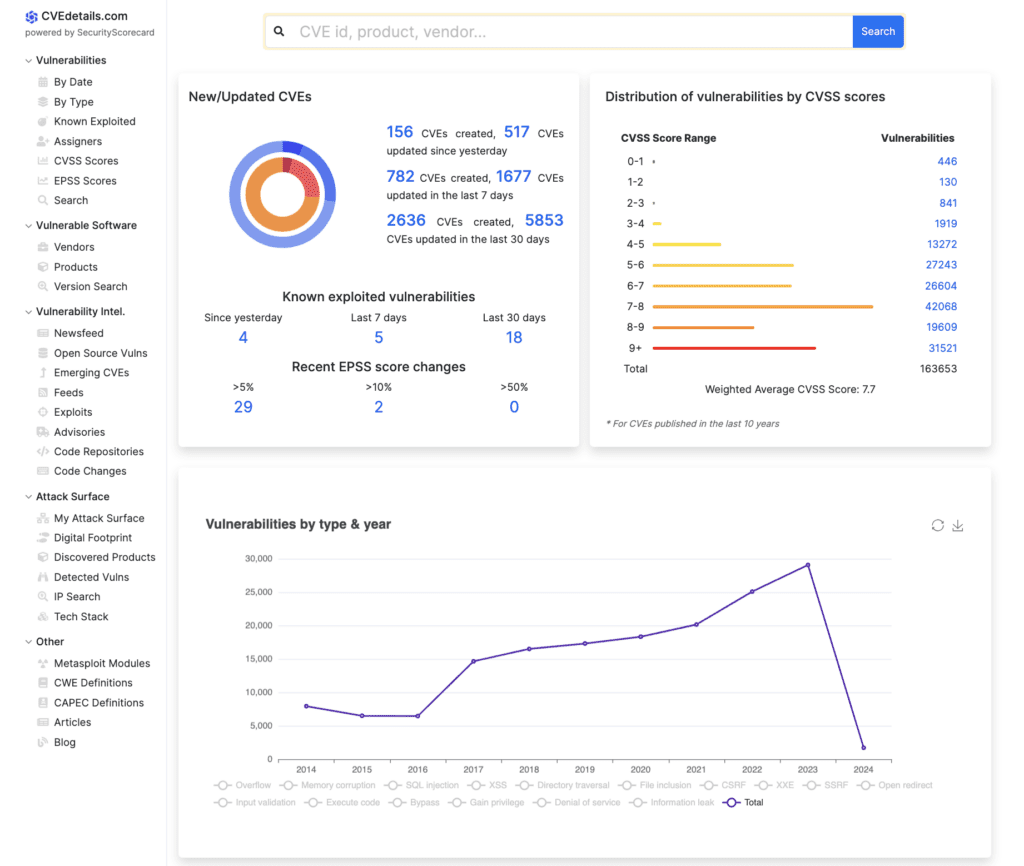
Source: SecurityScorecard
Remediation efforts are supported with dynamic action plans, allowing you to assign responsibilities and prioritize fixes.
Meanwhile, the Evidence Locker feature enables you to store, view, and share compliance evidence without having to chase multiple files, thereby streamlining document management and collaboration in general.
While its security monitoring and vendor management features are generally liked, users on both G2 and Trustpilot mention occasional scoring inconsistencies and false positives.
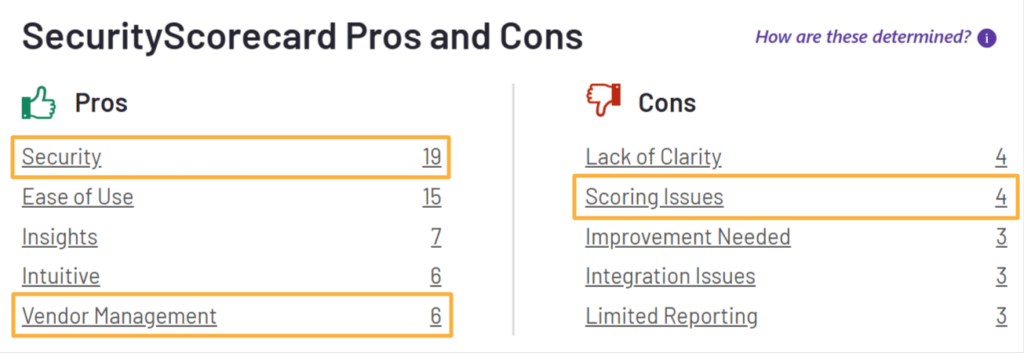
Source: G2
Such inaccuracies can overstate vendor risk, potentially leading to unnecessary follow-ups or strained supplier relationships.
One reviewer goes into more detail about the tool’s scoring issues and false positive rates, noting that this is both common and extremely inconvenient in cloud environments.

Source: Trustpilot
The pricing scheme isn’t fully disclosed, but a free plan lets you monitor up to five third parties with daily alerts, APIs, and automated reports.

Business and Enterprise tiers are custom-priced, with some reviewers noting that the cost may be prohibitive for smaller businesses.
Overall, SecurityScorecard is a solid option for organizations seeking large-scale external cyber posture assessments and valuing vendor collaboration.
Veridion is a data intelligence platform that delivers decision-grade company data to strengthen third-party and supplier risk management.
While cybersecurity and legal compliance are vital in TPRM, procurement teams also need a clear view of the flow of physical goods, digital information, and supplier business health.
Veridion’s datasets give you 95% of the intelligence you need to act, and do so without lengthy lead times.

Source: Veridion
Our expanding database currently covers over 134 million companies globally, with more than 220 attributes per profile, spanning firmographics, locations, ESG, and product data.
Weekly database updates keep the information fresh, while real-time access ensures you always draw on the latest available records.
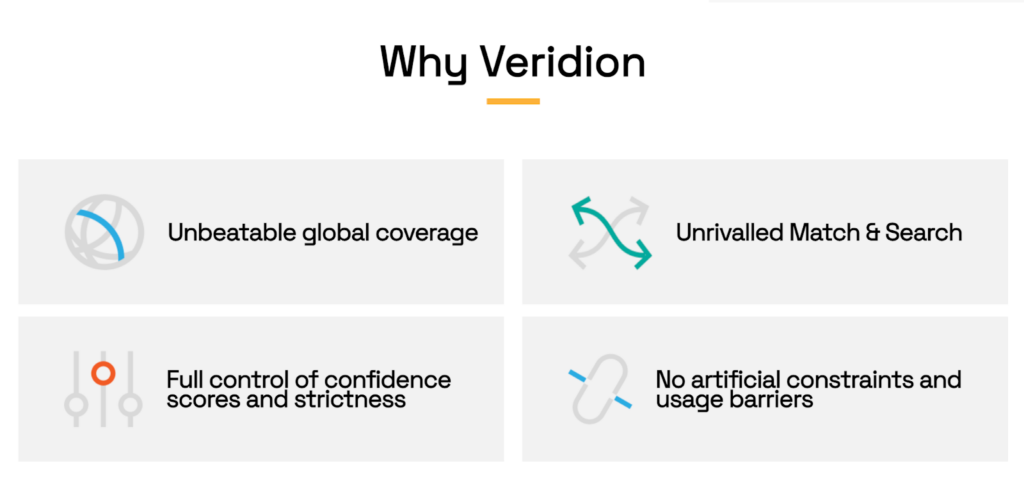
Source: Veridion
This balance of scale, depth, and freshness makes Veridion an essential companion for enterprises managing complex, fast-changing supply chains.
Natural language search is intuitive and allows for quick filtering, directing AI bots to scrape a company’s full digital footprint while consistently returning relevant, up-to-date information.
For TPRM use cases, specific attributes such as product data, corporate family structures, and sustainability news are particularly valuable.
Product data helps flag suppliers tied to restricted items; corporate family details reveal hidden ownership risks; and sustainability commitments provide ESG compliance context.

Source: Veridion
However, it’s important to note that Veridion isn’t a standalone TPRM platform.
Instead, it enriches vendor risk profiles with non-cyber dimensions like regional exposure, financial health, and supply chain diversification, as seen in the video below.
Source: Veridion on YouTube
Veridion delivers maximum value when integrated into existing risk tools, BI platforms, or internal analytics systems.
Flexible delivery options include APIs and tailored integrations, so data flows seamlessly into your chosen environment.
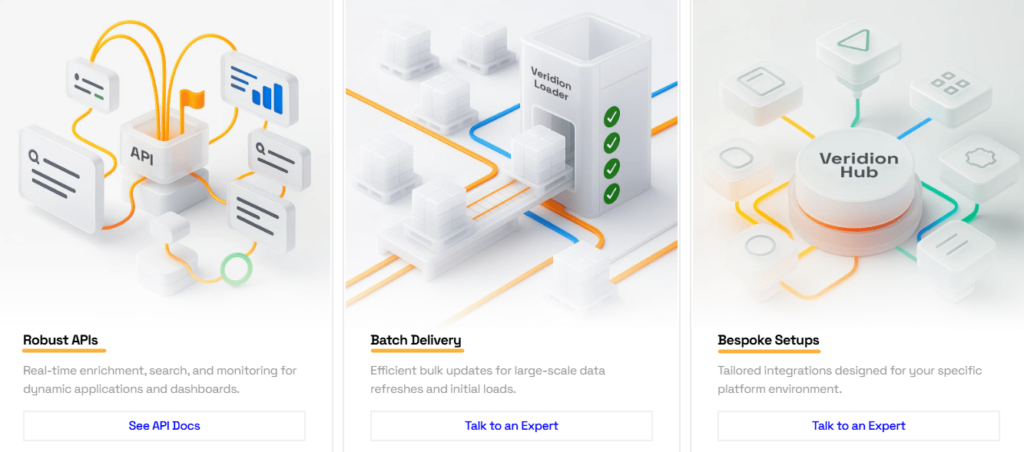
Source: Veridion
Veridion’s pricing is tailored to usage and scope, with utility-first schemes to match your needs.
You can check out available data samples on the web, but for a better assessment of your needs and more targeted data sets, feel free to reach out.
Ultimately, if you’re looking to enrich TPRM workflows with deep, always-fresh company intelligence, Veridion offers scale, speed, and flexibility that cyber-centric tools can’t match.
Bitsight is a pioneer in cyber risk ratings, assigning daily security scores from 250–900 based entirely on externally observable data, not vendor-supplied information.
It combines daily scoring, broad integrations (GRC, SIEM, and vendor platforms), and actionable intelligence to monitor both attack surfaces and vendor ecosystems at scale.

Source: Bitsight
Similar to UpGuard, Bitsight uses AI-driven scoring and explanations to accelerate TPRM efforts from vendor onboarding onward.
The AI-powered engine within Bitsight’s Continuous Monitoring product converts static compliance documents into structured, actionable insights.
As showcased below, it automatically maps evidence to frameworks such as SIG Lite, NIST CSF, and ISO 27001, giving you audit-ready reports with just a few clicks.
Source: Bitsight on YouTube
Bitsight also offers the Trust Management Hub, which streamlines assessments by enabling you to manage all requests and easily share security information from one central profile.
All the key information on pending and completed requests is available at a glance.
The hub also lets you securely store critical documents and completed questionnaires, as well as collaborate when necessary.

Source: Bitsight
This approach reduces repetitive work, speeds up security reviews, and supports faster revenue cycles, making Bitsight simpler than UpGuard or SecurityScorecard in some workflows.
However, some users mention certain hiccups related to vendor workflows and questionnaires.
Despite this, Bitsight receives praise for its clean interface and straightforward navigation on review platforms like G2.
Bitsight’s drawbacks, such as excessive notifications and occasional false positives, also affect some of the other tools on this list.
However, in Bitsight’s case, these issues are discussed more frequently in industry-specific threads.
As one Redditor notes, false positives are particularly frustrating because they can lower a score with limited options for correction.

Source: Reddit
In a reply to the original post, another user explains that Bitsight doesn’t actively scan devices directly, which can cause it to mistakenly flag random customer phones.
If you’re willing to look past this and manage such issues, here’s what you need to know about pricing.
Although subscription plans aren’t publicly listed, Bitsight provides detailed plan comparisons upon request.
To sum up, Bitsight offers a mature, integration-friendly platform for organizations that prioritize externally validated, continuously updated cyber risk ratings.
OneTrust’s TPRM module automates and streamlines vendor onboarding, assessment, monitoring, mitigation, and offboarding, all from within its GRC cloud ecosystem.
As with other solutions on the list, OneTrust provides continuous risk monitoring and custom alerts, but with a stronger emphasis on compliance and ethics reviews.
Namely, surfacing vendor risks goes beyond cybersecurity to include adverse media and reputational risk monitoring, sanctions checks, and watchlist screening.
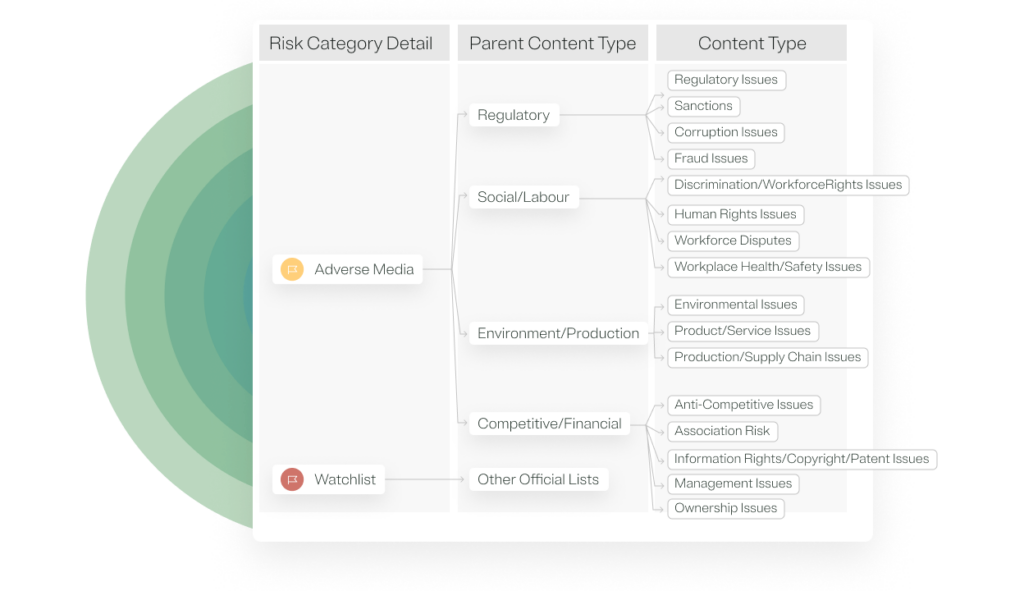
Source: OneTrust
Its TPRM Suite plan includes access to ethics and compliance databases from Dow Jones, while cybersecurity risk ratings are integrated from several providers, including SecurityScorecard.
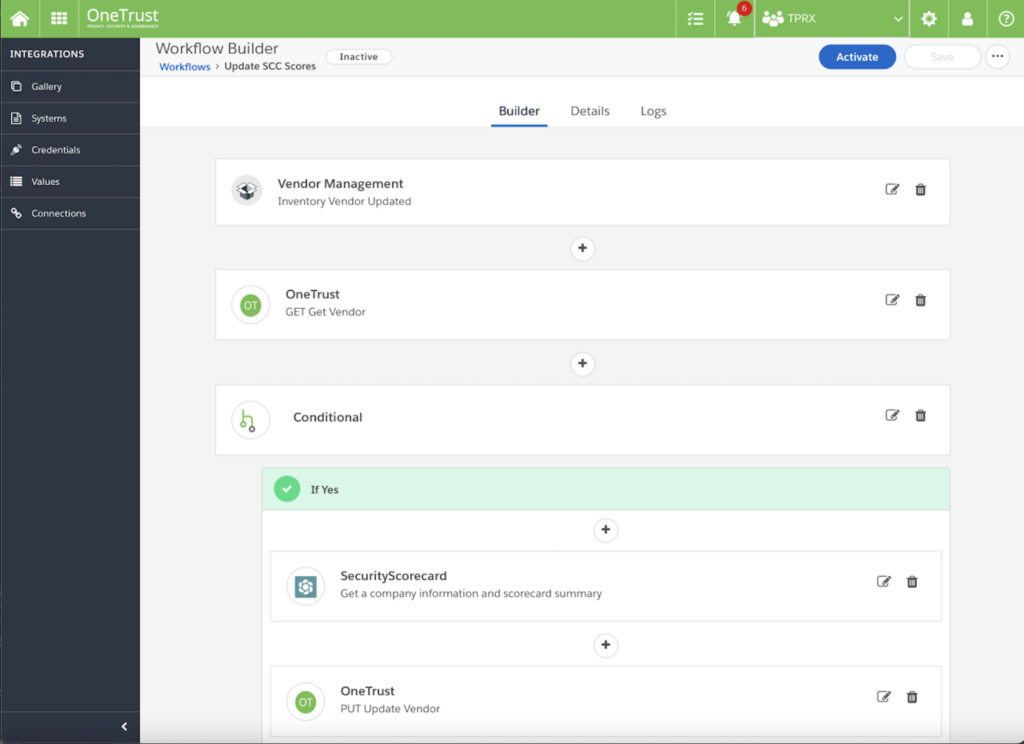
Source: SecurityScorecard
With the dedicated workflow builder, you can easily determine assessment priority and depth, and define integration workflows.
The software enables a fine degree of control over which workflows and notifications are triggered in response to real-time changes or new risks.
As a result, each vendor’s profile is clear and comprehensive.

Source: OneTrust
You can maintain editable vendor profiles in a unified catalog for complete visibility, access AI assistance, and leverage over 200 integrations.
This makes it well-suited for organizations seeking granular oversight and strong automation across the entire third-party lifecycle.
The platform is widely praised for its compliance-related features and interface, although some users on Capterra note that the UI can feel overwhelming due to the volume of information.
This aligns with one reviewer’s observation of a steeper learning curve.

Source: Capterra
In terms of pricing, OneTrust doesn’t disclose this information publicly, so you’ll need to contact them directly.
However, you can get a rough idea by reviewing the capabilities listed under each TPRM plan.
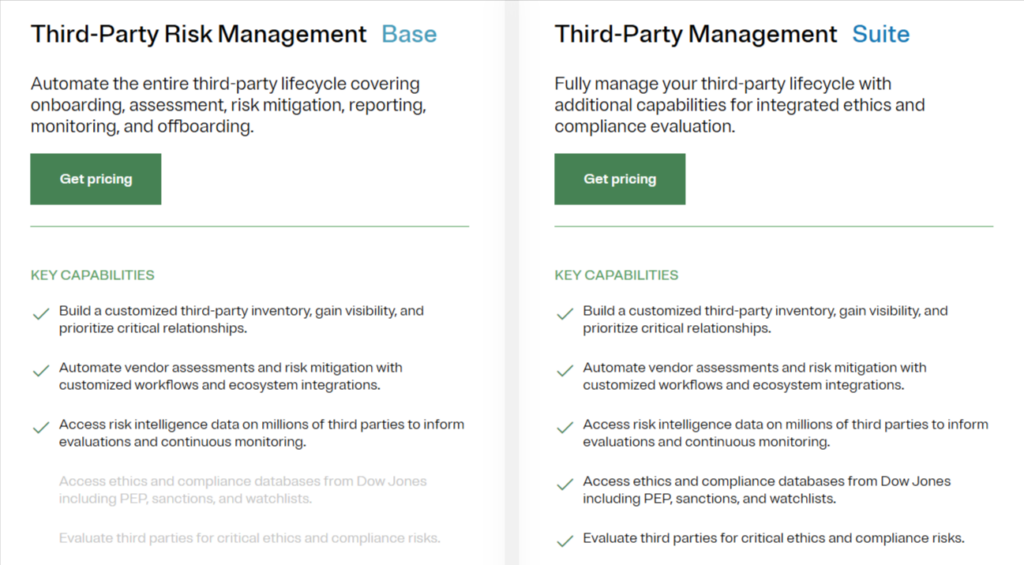
Source: OneTrust
Pricing is based on the number of admin users and the size of the third-party inventory, with additional modules costing extra.
One user also noted a lack of payment flexibility, as subscriptions are annual only.
If you’re looking for a deeply integrated GRC platform that centralizes vendor risk, privacy, and IT governance, OneTrust should be on your shortlist.
Mitratech’s TPRM tool, Prevalent, combines automated, standardized risk assessments with continuous monitoring, remediation workflows, and a global vendor intelligence network.
It offers a rich pre-configured assessment library with over 50 framework-based assessments such as SIG, GDPR, ISO9001, and PCI-DSS, in addition to 500 questionnaire templates.
These are mapped to regulatory standards, including NIST, ISO, GDPR, SSAE-18, and NYDFS through the Prevalent Compliance Framework, allowing teams to align risk data directly with relevant regulations.

Source: G2
Continuous risk monitoring spans operational, financial, legal, and brand risk domains, with insights integrated directly into assessment workflows.
Although there is little recent media on Prevalent’s site, likely due in part to its acquisition by Mitratech in 2024, this is the most up-to-date example available of what security incident monitoring looks like:
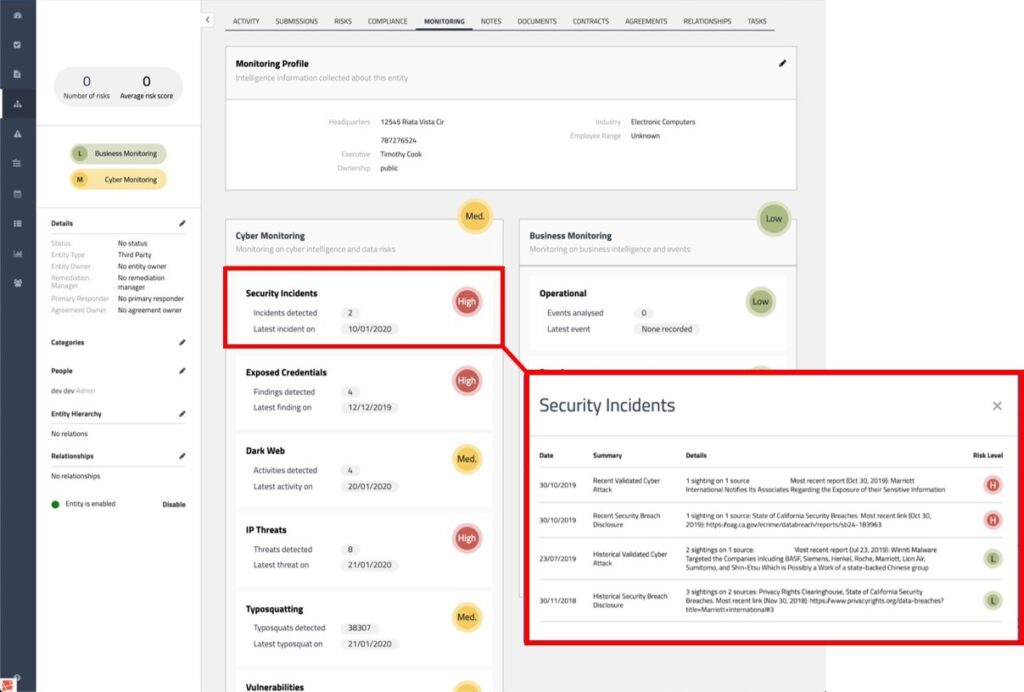
Source: G2
Monitoring capabilities are further enhanced through the vendor intelligence network, which provides access to pre-submitted vendor reports.
There are also optional managed services for organizations that need to scale programs quickly without adding significant in-house capacity.
By integrating sourcing, onboarding, assessments, monitoring, and reporting into a single platform, Prevalent aims to deliver a more unified approach.
However, this broad scope can come at the expense of the deeper specialization found in tools like UpGuard or OneTrust, or the continuously refreshed data offered by Veridion.
As Gartner analysis highlights, much of the positive feedback focuses on Prevalent’s ability to accelerate onboarding, along with responsive and helpful customer support.
Meanwhile, the outdated UI is the main recurring criticism, with one reviewer on Capterra expressing a similar sentiment.
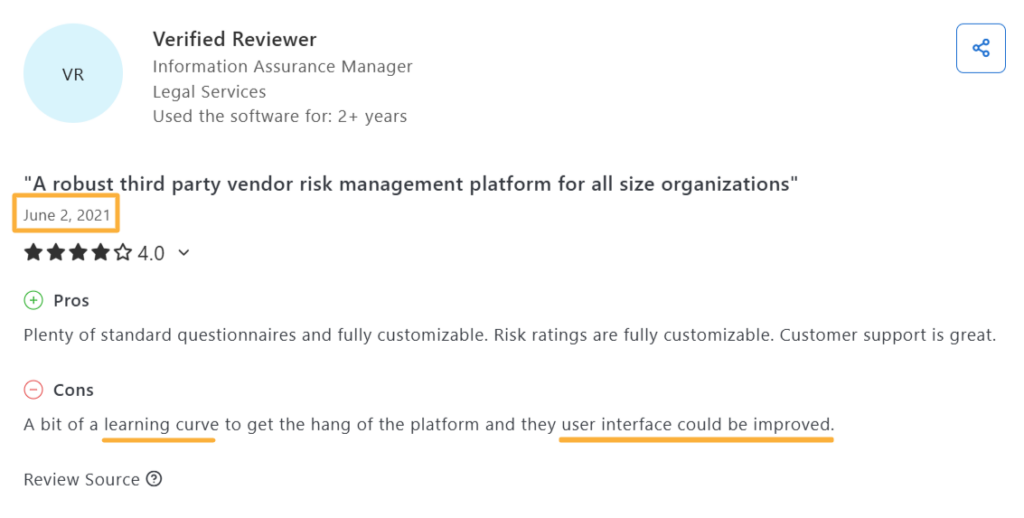
Source: Capterra
It’s important to note that most publicly available reviews are from 2021 or earlier, and should be taken with caution.
The platform’s post-acquisition direction may well address some of these concerns.
Prevalent doesn’t publish pricing details, so you’ll need to reach out directly for a quote or sign up for a demo.
If your organization needs to mature its third-party risk management rapidly with structured assessments, continuous monitoring, and optional managed services, Prevalent is worth considering.
Which of these TPRM tools resonated most with you?
Whether you prioritize cybersecurity monitoring, automation-driven workflows, or enriched company intelligence, the right software choice depends on your organization’s risk profile, data needs, and internal capabilities.
These reviews provide a helpful starting point, but be sure to request demos, explore the interfaces, and seek additional user feedback.
Ultimately, the best tool will integrate smoothly with your current processes while adapting to an evolving risk landscape.